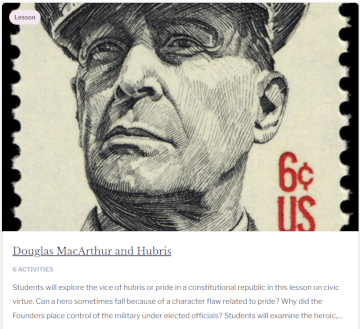Heroes & Villains is a collection of free, online lessons that explore both positive and negative character traits through studies of people and historical events of the past few centuries. The lessons, designed for grades seven through twelve, include interaction and discussion as occurs in class groups, perhaps meeting once a week. Nevertheless, the lessons are adaptable for use with one or a few students in a homeschool setting.
Of the 19 lessons available as I write this review, 14 are based on U.S. history. Among those lessons are “Thomas Jefferson and the Rewards of Humility,” “Douglas MacArthur and Hubris,” “The Responsibilities of Frederick Douglass,” “‘Boss’ Tweed and Avarice,” and “Roger Taney and Injustice: The Dred Scott Decision.” Since background knowledge of historical events should help students understand the context, I recommend using these lessons during or after students study U.S. history. The other lessons relate to the French revolution, Tiananmen Square, Nazi Germany, and Che Guevara. I think it would be ideal to pull in the pertinent lessons as each event is being studied in the student’s history courses, but the lessons can be used as a standalone course that can be completed in about one semester.
The lessons present deep questions that challenge students to think through what they believe regarding right and wrong, government authority, how much deference should be shown to those in authority, and other weighty topics. The focus is primarily on character qualities and critical thinking rather than advancing political viewpoints.
“Guiding Questions” are presented first in each lesson plan, and these underlie the questions that will be discussed. For instance, two of the four Guiding Questions for the lesson “John Brown and Self-Deception” are, “When is right of rebellion permissible under the Declaration of Independence?” and “Is it ever morally permissible to do a wrong to achieve a good end?”, and two of the questions for “Che Guevara and the Injustice of Communism” are “What role do governments play in providing justice?” and “Was the Cuban Revolution just—why or why not?”
The lesson plans are fully developed with tabs for materials, key terms, prerequisite background information, warm-up and wrap-up activities, homework, extension activities, and teacher resources. The materials section is where you find the content: an essay and a discussion guide plus other resources, such as one or two primary source documents, a brief article about the featured virtue or vice, a worksheet, an essay prompt, or instructions for an activity.
Lessons begin with a warm-up activity. Students will read the main article for the lesson (perhaps before class), then discuss it using the questions provided. Suggested answers are in the answer keys under teacher resources. (Parents and teachers can create a free account to access the answer keys.) Other activities follow the discussion. Most lessons can be completed in one session, especially if students read the main article in advance and complete lengthy writing assignments afterward.
The warm-up and wrap-up activities are very useful. For example, the Roger Taney lesson’s warm-up is a journal prompt: “Was there ever a time in your life when you had good intentions to solve a problem but things did not turn out as planned?” After students write on this topic, a parent or teacher guides a discussion, using the provided questions if needed. The lesson plan tells the teacher to ask, “How can I avoid this situation in the future with a greater sense of the virtue of humility?”
The wrap-up activity for this lesson has students write “a short paragraph explaining why injustice poses a threat to a republic.”
Warm-ups for other lessons might involve writing, completing a graphic organizer, brainstorming, or participating in a discussion. Wrap-ups typically involve discussion or writing. Extensions often venture into creative activities such as making flyers or posters or creating a video. The lessons always include an element of self-reflection and practical application for students.
Summary
Heroes & Villains is one of those intriguing resources that might just spark some of the most important learning experiences for students.








